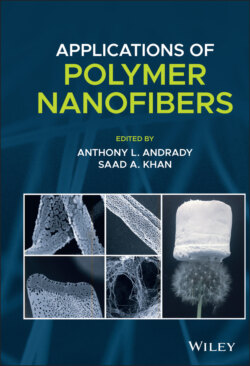Читать книгу Applications of Polymer Nanofibers - Группа авторов - Страница 41
2.2.6 Formation of Nanofiber Yarns
ОглавлениеThe approach to fabricate nanofiber yarns usually involves the combination of a spinning technique to produce aligned fiber bundles with a winding or twisting process to impose twists and strength (Carnell et al. 2008; Brown et al. 2011). The apparatus is accessible, while the main challenge is how to control the quality of yarns and achieve a high production rate.
Lee et al. prepared PU nanofiber filament yarns with good mechanical properties by electrospinning and dry twisting as shown in Figure 2.3 (Lee et al. 2012). PU nanofibers were first fabricated by electrospinning, then screwed into yarns by a twisting machine (Figure 2.3a). In the process, ribbon‐shaped PU nanofiber nonwoven fabrics were attached to the chunks of twisting machine, and the right‐side chunk was automatically wound. Then twists were imposed on the ribbons to shape a nanofiber yarn and make the yarn stronger. He et al. developed continuous PAN nanofiber yarns by double conjugate electrospinning (He et al. 2013). The components of double conjugate electrospinning setup are shown in Figure 2.4, which included a high‐voltage power supply, a metal funnel collector, two liquid transport tubes and supplies, four needle nozzles, and a yarn‐winding device. PAN nanofibers were electrospun from the nozzles, collected onto the rotary funnel, forming a nanofiber web, followed by drawing and twisting the nanofiber web into fiber yarns. By using this setup, nanofiber yarns could be obtained continuously and stably. Smit et al. established a water bath‐based setup for yarn spinning, shown in Figure 2.5 (Smit et al. 2005). It applied electrospinning onto a distilled water bath while collecting and rotating the as‐spun nonwoven web into a continuous yarn. PVAc, PVDF, and PAN nanofiber yarns were produced by this equipment. The resulting yarns could be well aligned with a favorable production rate of 180 mph. Yan et al. fabricated PAN nanofiber yarns by a homemade device based on a combination of eight needles electrospinning and yarn twisting machine (Figure 2.6) (Yan et al. 2016). This work used multineedles to speed up the production rate and combined two or more filaments to form folded yarns.
Figure 2.3 Photographic images of (a) twisting machine and (b) PU nanofiber strips.
Source: Reproduced with permission from Lee et al. (2012). Copyright 2012, Springer.
(c) Schematic of the dry‐twisting method.
Source: Lee et al. (2012).
Figure 2.4 Schematic of a dual conjugate electrospinning setup.
Source: He et al. (2013).
Figure 2.5 Yarn‐spinning setup with water bath collecting electrode.
Source: Smit et al. (2005).
Nanofiber yarns can also be achieved from island‐in‐the‐sea or segmented pie constructions through the spunbonding method. Fedorova et al. prepared island‐in‐the‐sea filament by using PA‐6 as island ingredients and PLA as the sea part. Different island numbers were designed to control the tensile strength of the produced yarns. The number of islands could be up to 360 units. It was concluded that the individual fiber diameter decreased with the decrement of island numbers, which could be as low as 0.36 μm (Fedorova and Pourdeyhimi 2007).
